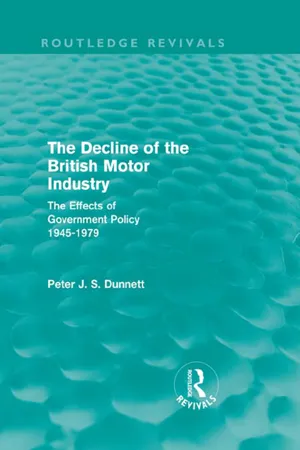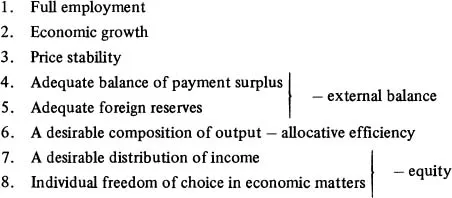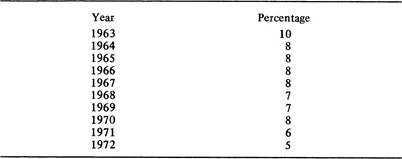![]()
This book is about the government and the motor industry. It is about how the government, in attempting to achieve various economic, political and social objectives, used and abused, helped and hindered, and generally modified the United Kingdom motor industry, both through direct and indirect actions.
Such an undertaking immediately raises a number of basic questions: What were the government's overall objectives? How did the government attempt to achieve these objectives? What was the importance of the motor industry relative to these objectives? How, in turn, could government policies in pursuit of overall objectives affect the motor industry? These questions are briefly examined.
What Were the Government's Overall Economic Objectives?
Since 1945 the governments of the Western World have accepted a general responsibility for the performance of their economies, and in economic matters the goals which they have sought to achieve have been very similar. In Britain, the Radcliffe Report of 1959 stated the economic goals or overall objectives of the country as follows:1
Economic policy, therefore, is a matter of attempting to achieve all these goals. Since this is impossible, given the current state of economics, such policy involves choosing by how much each goal should be sacrificed in order to gain that combination of outcomes which the government believes to be optimal. Whilst different British governments changed the emphasis given to each of these goals and set different priorities, the goals themselves have remained largely unaltered since 1945.
How Did the Government Attempt to Achieve its Objectives?
To achieve its objectives the government used economic policy instruments. Instruments might be of a general nature, such as a change in personal income tax affecting just about everybody, or of a more specific nature, such as a protective tariff on a particular sort of commodity, affecting only a small sector of the economy. Consequently it was possible for the implementation of policy to affect just about every segment of society, and in this book the emphasis is on the effects on the motor industry.
How Important Has the Motor Industry Been to the United Kingdom Economy?
Since World War II the motor industry has been a highly important leading sector in the British economy and, although in the private sector, has been very considerably influenced by government policy. A.G. Armstrong used input-output analysis to estimate the importance of the motor industry to the British economy.2 Directly, he estimated, the motor industry accounted for (i) about five per cent of industrial production between 1954 and 1966, (ii) about nine per cent of growth in industrial production in the same period and (iii) about 15 per cent of the uneven character of growth in industrial production. Indirectly, the importance of the motor industry was about the same, its requirements from other industries amounting to 3.9 per cent of industrial production in 1954 and 5.5 per cent in 1966. Overall, this implies that the motor industry was responsible for about 11 per cent of industrial production between 1954 and 1966. Furthermore, because of faster than average growth in the motor industry, as compared to industrial production as a whole, 27 per cent of growth in industrial production between 1954 and 1966 was attributable to the motor industry's growth. In 1975 the Central Policy Review Staff published The Future of the British Car Industry which stated the belief that the motor industry was still responsible for about 11 per cent of industrial output.3 Slower than average growth in the UK motor industry implied a smaller contribution to the overall growth in industrial production between 1966 and 1979 than in earlier years (see Table 1.1).
Table 1.1 United Kingdom Motor Industry Investment as a Percentage of Investment in all UK Manufacturing Industries, 1963–72
Source: National Economic Development Office, Industrial Review to 1977, Motors, p. 32.
How Could the Motor Industry Contribute to the Government's Overall Economic Objectives?
The motor industry's potential ability to contribute to the achievement of the government's overall economic objectives is quite straightforward. A vital and efficient motor industry is a provider of jobs and creator of incomes so contributing to full employment.
Table 1.2 Total Direct Employment in the Motor Industry, Selected Years
Sources: Central Statistical Office, Annual Abstract of Statistics; Parliament (Commons), Fourteenth Report of the Expenditure Committee, 1974–75: The Motor Vehicle Industry (HMSO, London, 1975), p. 48.
It also produces a product with a high income elasticity of demand, so that as per capita incomes increase, car demand increases more than proportionately and becomes yet more important to final demand in the economy: a prosperous motor industry is likely, therefore, to be a substantial contributor to economic growth. As an industry where opportunities for large productivity increases have traditionally been found, it is potentially capable of paying higher wages without experiencing increasing costs, so contributing to price stability and rising living standards. As an export industry it can help the balance of payments and the accumulation of foreign reserves. Operating at full capacity and structured to exploit available economies of scale, the industry can contribute to productive and allocative efficiency to produce a desirable composition of output. Finally, as a high wage industry it may contribute to a desirable distribution of income and, if it enjoys workable competition, provide choice to the consumer. The ability of the motor industry to make these contributions to the achievement of the goals set out by the Radcliffe Committee depends upon the structure, conduct and performance of the industry. By introducing policies which alter these, a government can move towards or away from any of its particular overall economic objectives.
How Could Government Policies in Pursuit of Overall Objectives Affect the Motor Industry, Either Directly or Indirectly?
Government policy affected the motor industry in three different ways. First, policies were aimed directly and specifically at the motor industry in order to achieve a particular goal. For example, in 1960 the government refused industrial development certificates to the motor industry in order to force the industry to relocate in areas of high unemployment. Here was a policy specifically applied to the motor industry, causing a fundamental geographical relocation, in order to provide greater equity in the distribution of income. Secondly, policies were aimed at a broader sector of the economy but still had a direct influence on the motor industry. For example, the government frequently used hire purchase restrictions on all consumer durables including cars as a means of controlling aggregate demand. At times this caused excess capacity to develop in the motor industry raising unit costs and affecting industry performance. Thirdly, policies were made which only indirectly affected the motor industry. For example, after the war, following the Beveridge Report, the British government committed itself to high priority for the social services. As a result, expenditures on transport, in general, were neglected. One facet of this neglect was very low expenditures on the roads. Consequently, British cars were designed for an antiquated road system and were unsuitable for the more modern highways found in many export markets. Thus, as a result of the government stressing social services and the overall equity goal, the motor industry made a smaller contribution to the balance of payments and economic growth than might otherwise have occurred.
This book undertakes to examine the adequacy of government policies as they affected the motor industry. Alternatively, its aim can be put in the following form. Between 1945 and 1979 the British motor industry suffered a dramatic relative decline in efficiency, competitiveness and world importance. Government policy strongly influenced structure, conduct and performance in the motor industry. These facts raise two questions. First, was government policy between 1945 and 1979 to any extent a cause of this decline, as opposed to having a neutral or restraining influence on the decline? If the answer to the first question is in the affirmative it still raises a second question. Was this relative decline in the one industry a worthwhile sacrifice in that it made it possible for the government to attain more closely its overall economic objectives?
This book seeks to provide a full long-run economic analysis of how post-war government policy permeated through to affect almost all aspects of the conditions in which the UK motor industry operated. To date, commentators have tended to concentrate either on labour relations and management in the motor industry or on the nature of the product. For the past decade the media has been rife with reports about impossible trade union demands, incompetent management, the generally poor quality of British cars and the weak overall performance of the UK motor industry. In this book it is argued that often labour and management problems, which frequently received the attention in criticism of the UK motor industry, were themselves not causes but symptoms, and that often the cause of their problems was to be found in government economic policies. Nevertheless, the importance of the effect of government policy on the UK motor industry has not gone completely unnoticed. In 1956 Roy Jenkins, later British Home Secretary and President of the European Economic Community, said,
In every conceivable way the future of the motor industry is bound up not only in its ability to solve its own problems but with the framework within which the government are to allow it to apply to these problems … the industry is operating within a constantly changing framework and will continue to do so in the future, and the authority that determines that framework is the government.4
And a decade later The Times with singular foresight commented,
Too many factors depend on [the motor industry] … for any government to ignore its general health or neglect to provide the conditions in which it can thrive.5
At the outset it should be made clear that the purpose of this book is not simply to attack government intervention with the benefit of hindsight. It is hoped the book provides a learning exercise. Certainly, as will be seen, the government made mistakes, and in some circumstances policy is foun...



